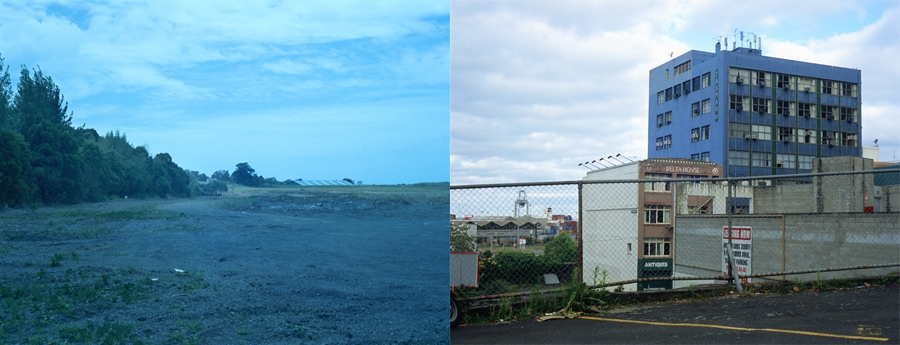By Lisa Crowley
Michelle Menzies’ installation Passings, presents us with images taken of various spaces around Auckland. There are two photos, one of an empty carpark, which looks out over the city port, the other a disused quarry in St Johns. A third work, House Study is a video projection of an old, large villa from an inner city Auckland suburb.
The works evoke feelings of absence and abandonment. Spaces that were once an active part of the city have now been given over to a sense of depletion, signalled by the accumulative passing of time. Robert Smithson in his 1968 essay “A Sedimentation of the Mind” describes how these entropic processes of time also manifest as a form of perception inside the human brain.
The brain itself resembles an eroded rock from which ideas and ideals leak…. when a thing is seen through the consciousness of temporality it is changed into something that is nothing. (1)
For Smithson, meaning and ideas, rather than becoming clearer, fall away as the mind moves out of a mode of production and into a consciousness of time.
The wasted spaces in which Menzies is interested also defy the laws of production. They are small pockets of territory that negate the proliferating density of the city space around them. Her translation of these sites into digital images is predicated on a perceptual and aesthetic logic. The ghostly, split image of the ruined house in her video projection falls short of any attempt to overtly psychologise or pathologise the viewer. To do so would be to treat her subject in terms of meaning rather than effect. Menzies is not interested in eliciting or isolating specific emotional responses from her audience, instead she subtly troubles one’s abilities to discern and make sense of something; a colour, a sound, a space, a moment. This aesthetic consideration and conceptual restraint aligns her work with the practice of Zarina Bhimji, Tacita Dean and Kaucyila Brook as well as the cinematography of Agnes Godard. Each of these artists is engaged with undoing, breaking-down a structure of experience based on the production of meaning and signification. In different ways their work traces the phenomenon of temporality and the subtle effect of this on how we perceive the world around us.
While Passings engages with the idea of the wasteland, like the artists above, the work is also cognisant of the specifics of place. The locations in the 2 photographs are quietly, slightly familiar. The strange, saturated colour casts and blocking of perspectival space build a sense of duration into the images; a feeling of incremental moments, shifts, slumps and calibrations that occur in the perception of time passing. This zone of perception that Menzies navigates and observes the city through allows us a clarifying distance – the small ruined zones of nothing momentarily stall and antagonise the idea of a city as a coherent, productive, capitalist space.
(1) Robert Smithson, ‘A Sedimentation of the Mind: Earth Projects’ from Robert Smithson, The Collected Writings, ed. Jack Flam, publ. University of California Press, Berkeley, California, 1996
http://filmarchive.org.nz/
This is the catalogue essay for Michelle Menzies’s exhibition ’Passings’ exhibited at the NZFA, Auckland in March 2004.
